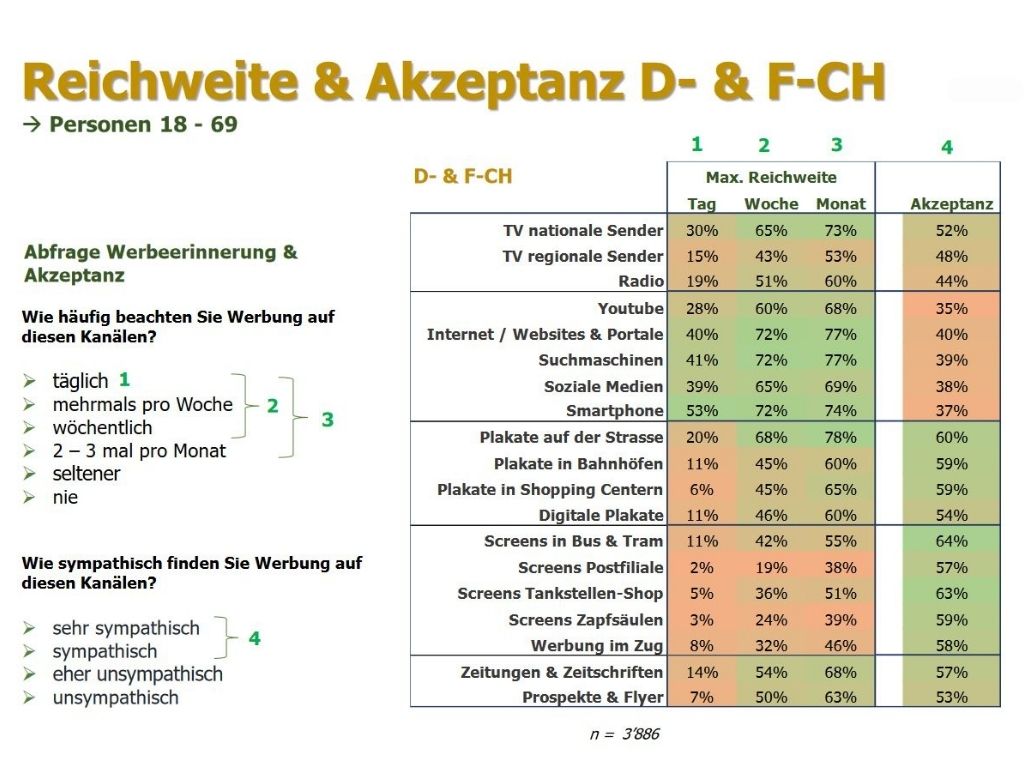 The advertising companies were asked about their assessments of and outlook for the Swiss advertising market. Despite uncertainties, 50% expect revenues to rise and 35% to remain stable in 2023. Around a quarter of respondents anticipate a decline in revenues. Most, however, expect revenues to remain flat or increase. Despite this outlook, many advertisers are taking a cautious approach to budgeting. While around half of the companies want to invest the same amount of advertising money, the number of those who want to invest slightly less this year is rising.
The advertising companies were asked about their assessments of and outlook for the Swiss advertising market. Despite uncertainties, 50% expect revenues to rise and 35% to remain stable in 2023. Around a quarter of respondents anticipate a decline in revenues. Most, however, expect revenues to remain flat or increase. Despite this outlook, many advertisers are taking a cautious approach to budgeting. While around half of the companies want to invest the same amount of advertising money, the number of those who want to invest slightly less this year is rising.
The majority of advertisers want to invest about the same amount of money in communications in the new year as last year (49.2%). However, the proportion of those intending to invest less this year is slightly higher (31.8%) than of those intending to spend more (18.9%). This intention is also reflected in the planned media budget: for 54.6% it remains unchanged, for 26.5% it decreases and only for 18.9% of the respondents it increases.
Channel distribution remains constant
When asked about the allocation of funds to marketing channels, respondents will invest 34% of their budget in offline media. Last year, the figure was slightly higher at 35%. The rest of the breakdown remains similar to last year: digital advertising (15%), social marketing (12%), event marketing (11%), website (8%), SEO (8%), email marketing (4%), mobile marketing (3%), digital commerce (3%) and channel/affiliate marketing (3%).
Brand management remains important
As last year, the creation of independent and relevant brand worlds still seems to be of central importance. This is shown by the thematic distribution of funds among specific marketing disciplines. Content/campaign creation and branding continue to be in the foreground. Sales support and marketing operations follow in third and fourth place.
Digital before offline
When it comes to the question of how the media budget will develop within digital and offline, the pendulum once again swings in the direction of digital. There, 42.5% want to invest more in the new year and only 11% less. In response to the same question, only 10.9% more want to invest in offline media and a whopping 42.3% less. Exactly the same number of respondents want to invest the same amount in digital and offline media this year (46% each).
Outdoor advertising, direct marketing and cinema in vogue
In terms of offline media, OOH/DOOH, direct marketing and cinema are once again more in demand than in the previous year. There, the proportion of those who want to invest more is higher than those who want to invest less. The opposite is true for TV, print and radio.
Distribution of offline budget: OOH, TV and print
In terms of the specific distribution of the media budget, OOH/DOOH (27%) TV and print (26% each) are in particularly high demand this year. These are followed by direct marketing (17%) and radio (3%). Little can be expected from cinema and "others" such as events, POS or brochures with 1% each.
Something more direct than programmatic
Advertisers plan to allocate about 53% of their digital budget via direct bookings in 2023 and 47% programmatically.
Distribution of online budget: Google Search, Meta and Youtube
The most popular digital advertising formats in the new year are display, search and video. Here, advertisers plan to allocate their budgets to the advertising inventories as follows: Google Search 27%, Meta 20%, YouTube 16%, Premium Publisher Networks 10%, LinkedIn 7%, Open RTB Networks 7%, Premium Publisher Single Sites 5%, TikTok 4%, Snapchat 1%, Bing 1% and Other 3%.
Improving customer experience is more important than uncertainty
The very important challenges cited this year are improving the customer experience (49%), digital transformation (47%), data management (45%), and customer journey management (43%). Summarizing the very important and significant challenges, the order is as follows: Improving Customer Experience (94%), Data Management (88%), Digital Transformation (86%), Demonstrating ROI (86%), and Choosing the Right Technology (85%). Slightly less important to respondents at present are topics such as artificial intelligence, market uncertainties, shaping organizational change, or shorter time to market.
Personal recommendation remains most important in agency search
Recommendation (80.6%) is still the most important source of information for selecting an agency. Contacts with agency management are slightly less important this year (55.6%) followed by the agency website/appearance (51.4%) and the trade press (29.2%). Rankings and awards play a less important role in this regard.
Chemistry and skills most important
The most important criterion in agency selection is still personal chemistry and cultural fit (94.4%). Followed by an agency's mission/competencies (91.3%), references (59.7%) and agency size (26.4%).
Chemistry Meeting and competition presentation most often
In the new year, Chemistry Meeting is clearly the most used for agency evaluation (32.3%) followed by Competitive Presentation (27.6%). The award of a trial contract has increased in importance compared to 2022. This is followed by direct award and written request for proposal.
Agency services for content and digital
In 2023, advertisers increasingly want to work with agencies in the disciplines of content, digital, analytics, branding and creation. Collaboration for live com or corporate communications is somewhat less in demand and, at best, will be handled by the agencies themselves.
Offers and expense fee most popular
Advertising clients continue to be very interested in fees in the form of offers/scope of work and agile pricing based on time and effort. This year, there was a slight increase in team hire, and the fee based on success parameters is hardly used at all. The latter is generally only used as a supplement to the basic fee.
In the "Industry Indicator 2023" survey conducted by SWA and LSA between October and November 2022, a total of 174 well-known advertising clients in German and French-speaking Switzerland took part online. The detailed results can be obtained from the offices of the two associations.
Swiss Association of Advertisers (SWA)
Roland Ehrler, Director
T +41 44 363 18 38
roland.ehrler@swa-asa.ch
LEADING SWISS AGENCIES
Catherine Purgly, Managing Director
T +41 43 444 48 18
catherine.purgly@leadingswissagencies.ch













 Why are there campaigns that only achieve unsatisfactory awareness effects despite high reach and contact intensity? To find out, Die Marktforscher conducted a new advertising impact study in German- and French-speaking Switzerland based on a total of 3,886 interviews. The reach and acceptance of all relevant media types were examined.
Why are there campaigns that only achieve unsatisfactory awareness effects despite high reach and contact intensity? To find out, Die Marktforscher conducted a new advertising impact study in German- and French-speaking Switzerland based on a total of 3,886 interviews. The reach and acceptance of all relevant media types were examined. With the "Sélection Grand Hotel", the figurehead of Länggass- Tee's B2B product lines was at the center of the intended harmonization and redesign. Previously kept in plain black, the 18 varieties, known in particular from the catering and hotel trade, now reflect the diversity of tea culture with their respective color nuances. With the "Édition Classique" and the "Édition Supérieur", the range has also been expanded to include two extensive resale lines.
With the "Sélection Grand Hotel", the figurehead of Länggass- Tee's B2B product lines was at the center of the intended harmonization and redesign. Previously kept in plain black, the 18 varieties, known in particular from the catering and hotel trade, now reflect the diversity of tea culture with their respective color nuances. With the "Édition Classique" and the "Édition Supérieur", the range has also been expanded to include two extensive resale lines.
 The advertising companies were asked about their assessments of and outlook for the Swiss advertising market. Despite uncertainties, 50% expect revenues to rise and 35% to remain stable in 2023. Around a quarter of respondents anticipate a decline in revenues. Most, however, expect revenues to remain flat or increase. Despite this outlook, many advertisers are taking a cautious approach to budgeting. While around half of the companies want to invest the same amount of advertising money, the number of those who want to invest slightly less this year is rising.
The advertising companies were asked about their assessments of and outlook for the Swiss advertising market. Despite uncertainties, 50% expect revenues to rise and 35% to remain stable in 2023. Around a quarter of respondents anticipate a decline in revenues. Most, however, expect revenues to remain flat or increase. Despite this outlook, many advertisers are taking a cautious approach to budgeting. While around half of the companies want to invest the same amount of advertising money, the number of those who want to invest slightly less this year is rising.



 The great personal branding handbook
The great personal branding handbook


